Backdrops in mame2003-plus
-
@Clyde said in Backdrops in mame2003-plus:
I'm just biased to 4:3, guilty as charged
Art for Gorf is actually a bezel with lamps so I'm not sure you have enough sidebar space for the "ranking lamps". What is the game area for Gorf on 1600x1200?
-
@Riverstorm You're mentioning and seeing so many great artists! I like many of them too, starting from Eagles. It's a big advantage to live in the US; many opportunities to see 'em.
About Toto I'd suggest you listen ISOLATION if you have a chance, quite different from their usual Albums, much more powerful rock than their usual style. -
@UDb23 said in Backdrops in mame2003-plus:
About Toto I'd suggest you listen ISOLATION if you have a chance, quite different from their usual Albums, much more powerful rock than their usual style.
I will definitely grab a copy of Isolation. We have a great second hand music store here that I like to frequent. They are really good with carrying older music or hard to find stuff. I try to find the early pressings as the dynamic range is usually better and the albums aren't victims of the "loudness wars". Some of the music I didn't care for back then have become favorites years later. I just grabbed some of Foreigner's "middle years" stuff that I am enjoying.
My wife and I splurged quite a bit for 2nd row seats to the Eagles, it was an incredible concert. They sound so good live. The 1st row was just way to expensive. We semi-splurged for Kiss and are in the 16th row. Most of what I like from Kiss is '79 and older starting from Dynasty.
-
@UDb23 said in Backdrops in mame2003-plus:
Art for Gorf is actually a bezel with lamps so I'm not sure you have enough sidebar space for the "ranking lamps". What is the game area for Gorf on 1600x1200?
My question was mainly meant for your 16:9 version, since I also suspect it would be a little cramped on the sides in 4:3. There, it may be better to just use the bezel. Bezels are one main reason I chose a monitor with such a high native resolution like 1600x1200 anyway.
But nonetheless, here's a screenshot that shows the game area on 1600x1200 with an aspect ratio of "core provided" and without any shaders applied.
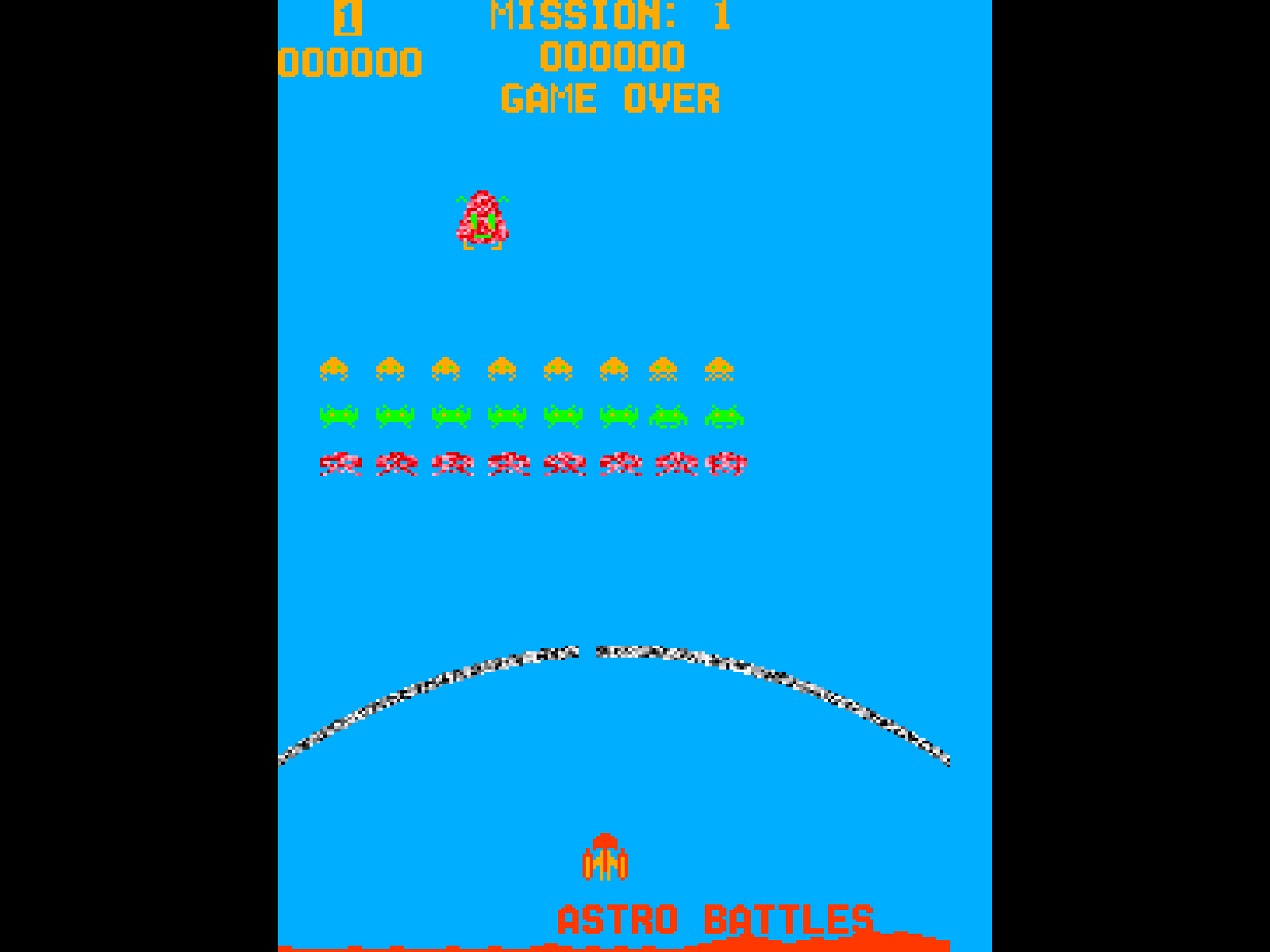
-
@Riverstorm said in Backdrops in mame2003-plus:
My wife and I splurged quite a bit for 2nd row seats to the Eagles, it was an incredible concert.
Seats at rock concerts seem to be one big difference between the USA and Germany (Europe?). Here, most if not all concerts except for "sitting" genres like classic and jazz don't have seats. Although this has its disadvantages for small people or who can't stand for such a long time, it allows for a much better "rocking" atmosphere and dancing in the crowd. What do you think about that? (and @UDb23 as a fellow European)
-
@Clyde said in Backdrops in mame2003-plus:
1600x1200 with an aspect ratio of "core provided" and without any shaders applied.
It looks there's enough space.
Can you let me know the game res in the RA menu (settings, video)? -
@UDb23 Sorry for the late answer, I fell asleep right after dinner yesterday.
I don't see any game resolution in the XMB menu under Settings > Video. But mame2003-plus' XML file says that Gorf has a <video_screen> of 204x320 with an aspect ratio of 3:4.
-
@Clyde said in Backdrops in mame2003-plus:
No screen res under video settings is quite strange. The RA menu (not xmb) on the Pi shows it. Anyway, being 3:4, I suppose it's 900x1200.I fell asleep right after dinner yesterday.
happens; you're not the only one :-)
-
@UDb23 I switched to RGUI and there's still no game res showing. Where should it be? These screenshots are made while running Gorf:
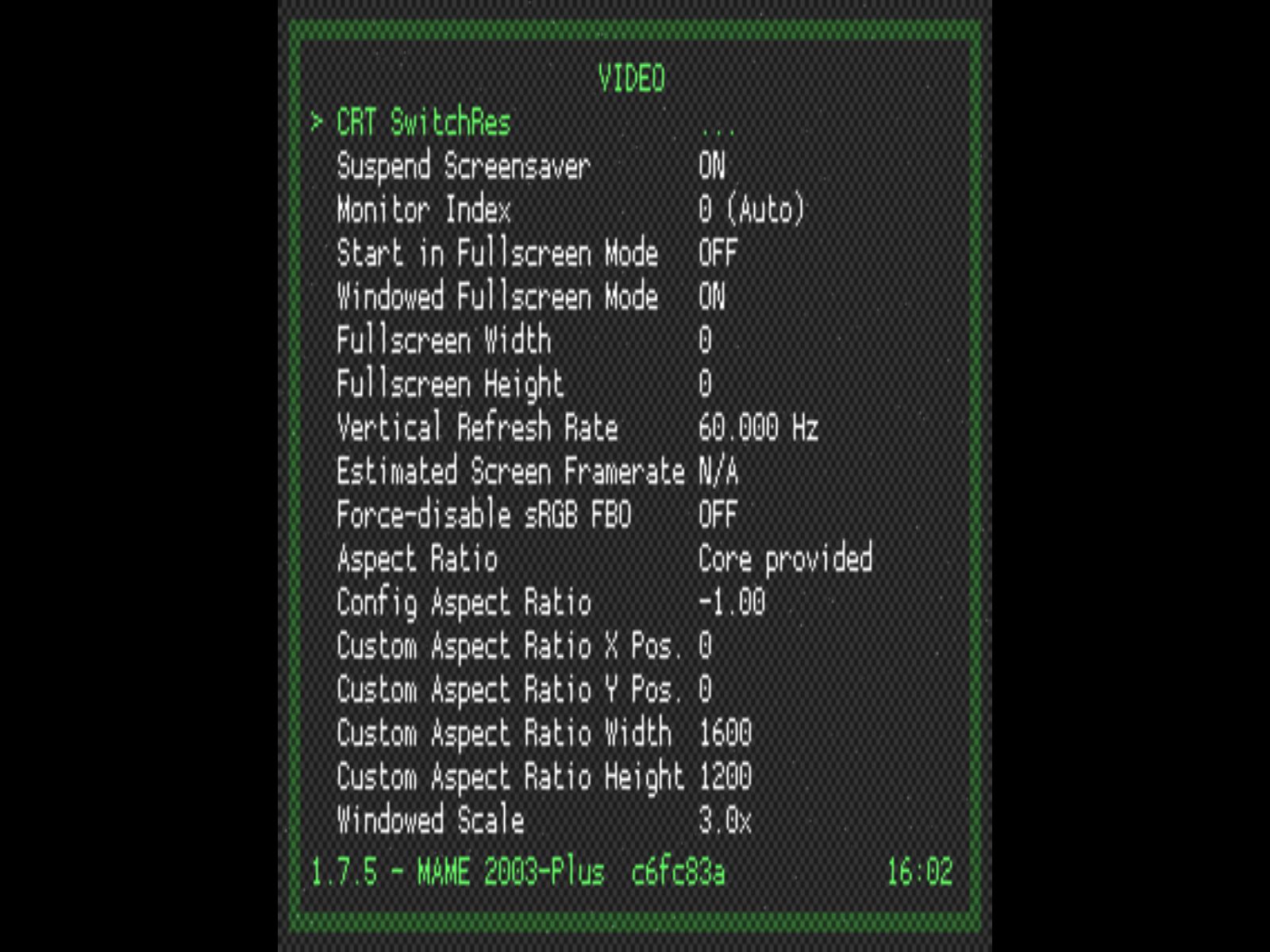
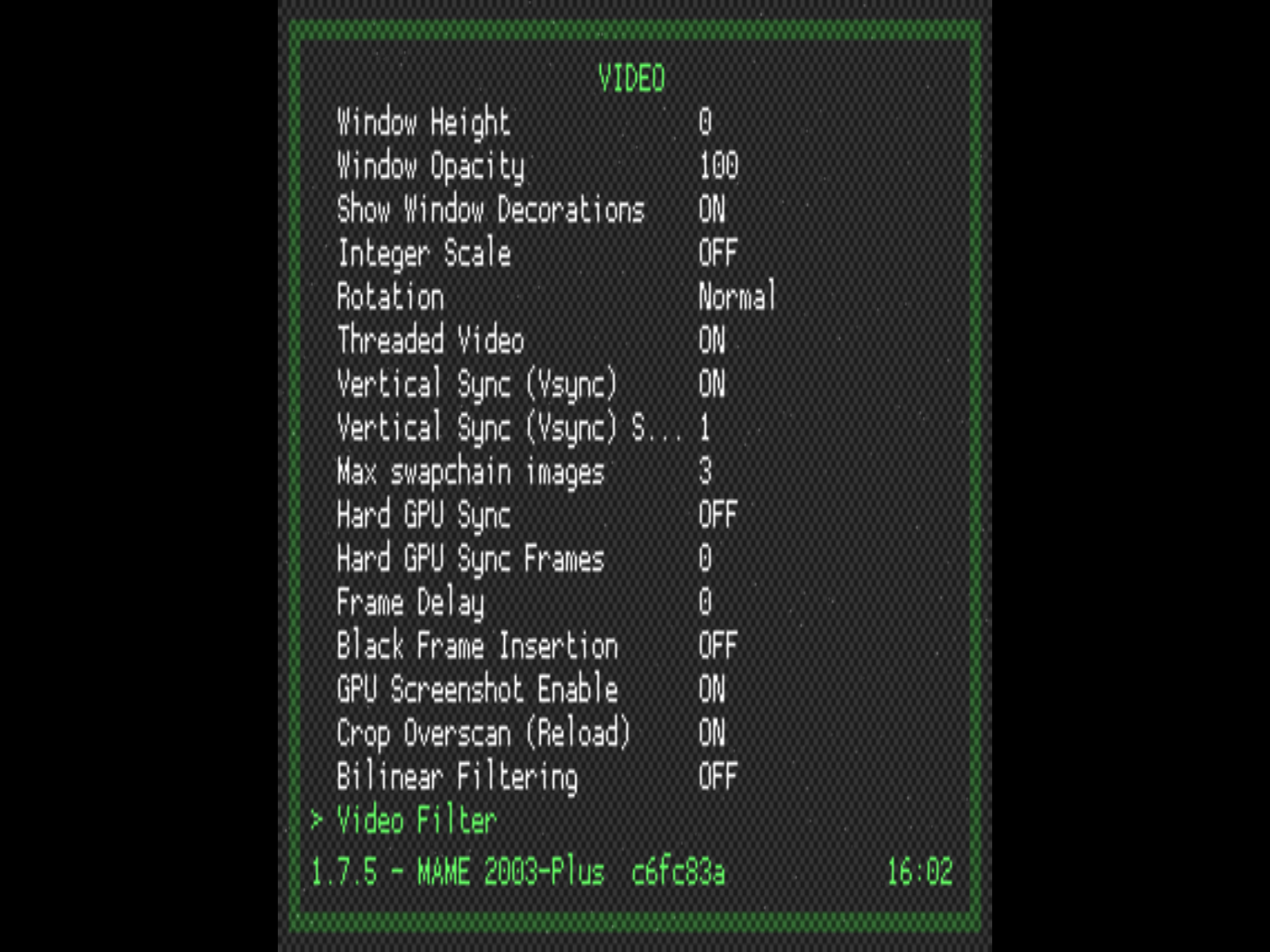
-
@Clyde - That's interesting. It should be where it shows
Fullscreen WidthandFullscreen Height. -
@Riverstorm The description of
Fullscreen Widthsays that it will use the desktop resolution if set to0. Without a desktop (i.e. using the normal Retropie image), I guess this applies to the framebuffer resolution.I didn't change that setting as far as I remember. So it is interesting why it's different for you and @UDb23. Are you using the normal Retropie image on a Pi?
-
@Clyde - I apologize I didn't have my advance options turned on. I am using RetroPie 4.4.4 on a Pi 3B+ and a fairly recent m3plus commit and RA 1.7.5. Here's a screenshot of RA inside Gorf to compare. This is on a 1920 x 1200 monitor.
Can you explain a little more on what you mean by framebuffer resolution? Isn't "render resolution" done at a lower res and then the final frame is upscaled to what you see under the video options?
I wonder if that new resolution Grant setup for you is why yours is different. You're game aspect ratio looks correct on screen even though the core provided numbers are 4:3 vs 3:4. They aren't what I would expect to see, like @UDb23 pointed out I would calculate core provided to be 900x1200.
The area I am referring to is the
Custom Aspect Ratiosettings underAspect Ratio. Basically you're seeing your display resolution and not the game resolution we typically find with these settings. I don't know how you would get your "game resolution" because the numbers don't reflect it. That's interesting.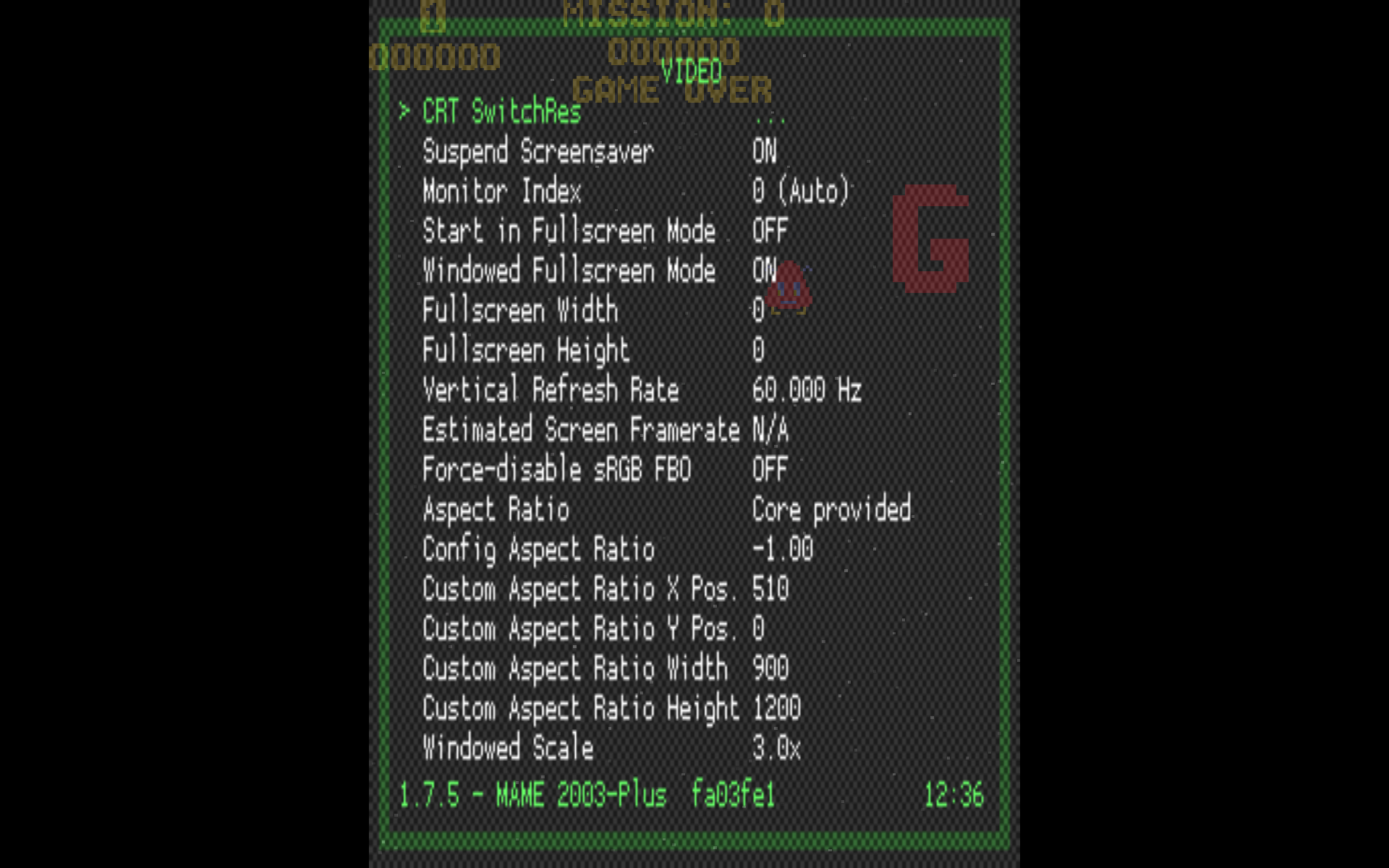
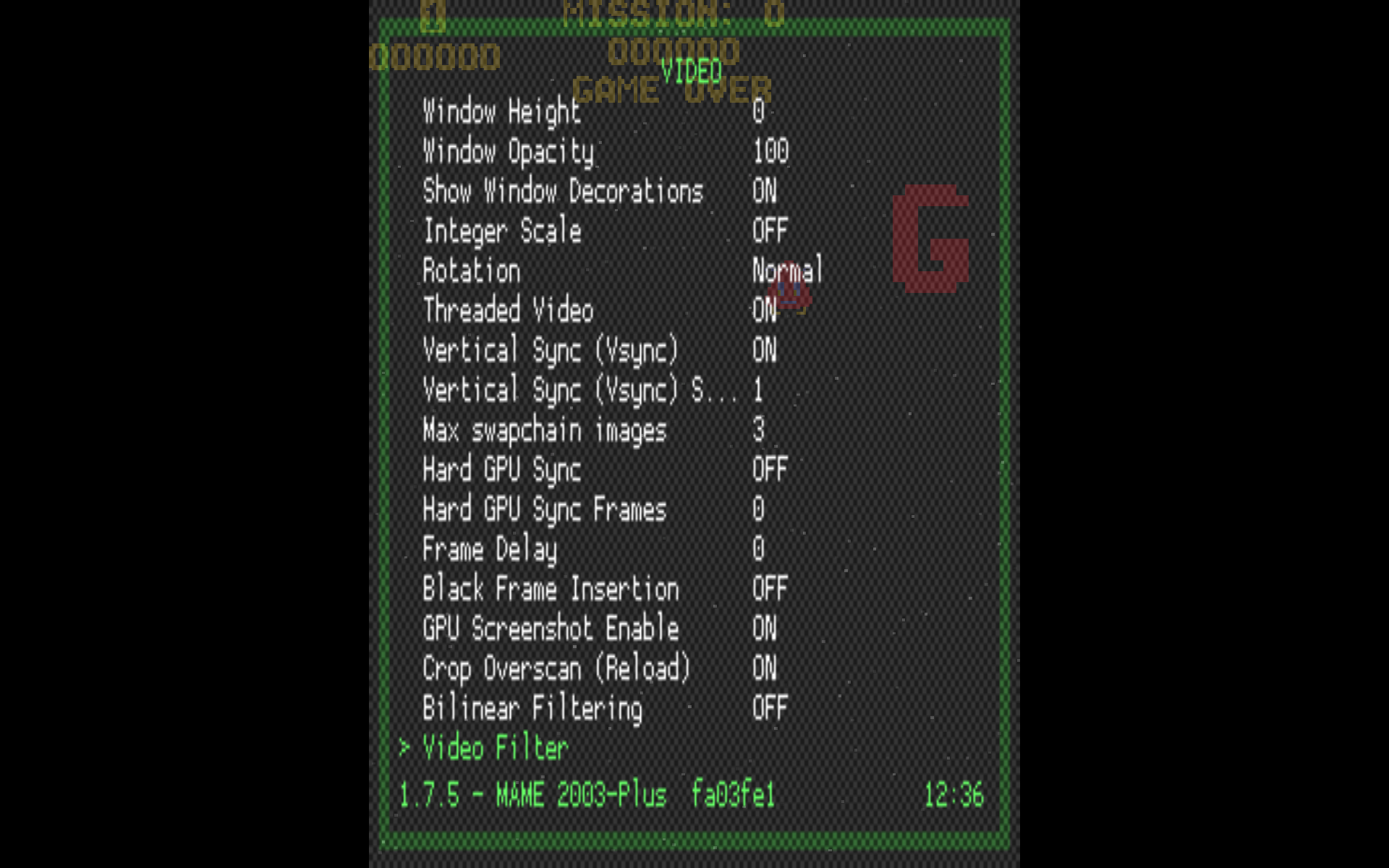
-
@Clyde - Looking at your screenshots you're actually rendering at a true 1600x1200 it seems but I'm not sure. Which would be slightly more resource intensive than the typical
Core Provided900x1200. I don't know if you would gain much in raster games vs. vector there's a definite advantage. -
@Clyde As @Riverstorm already said, it is quite strange that your game area, looking at the gorf game screenshot, uses part of the screen but RA reports full 1600x1200 as custom viewport.
Maybe some special global retroarch setting ? -
@Riverstorm Since the official Retropie image doesn't have a desktop, I suspect that the "desktop resolution" RA will use if you set
Fullscreen WidthandHeightto zero may be the framebuffer resolution on the official Retropie sd card image instead, since it doesn't have a desktop environment installed. You can (re)set the framebuffer via thefbsetcommand, see https://retropie.org.uk/docs/Video-Issues/#reset-the-frame-buffer-after-changing-the-video-mode for an example.The game area of Gorf is 3:4 and the screen resolution of my monitor is 4:3. I don't quite understand why this seems to be confusing to you, care to elaborate, please?
I also think that RA/mame2003-plus always has to render the whole screen resolution, because I doubt that most monitors would display a mere 900x1200 picture correctly. Please tell me if you see an error in my reasoning.
@Riverstorm @UDb23 According to the descriptions in the XMB interface mode (which is one of the reasons I prefer it to the RGUI mode), the custom viewport settings are only used if
Aspect Ratiois set to "Custom", which it isn't in my case. I may have set the values to 1600x1200 for testing purposes some time in the past, but they shouldn't affect the picture at all withAspect Ratioset to "Core provided". -
@Clyde - I don't if this will help. I don't believe the official RetroPie image has a specific resolution set. It's all based upon the display resolution the Pi detects. Sometimes I plug my Pi into a 1440x1080 display and sometimes a 1920x1080 and it auto-detects the displays correct resolution. Then
Core Providedsets the game resolution accordingly based on that detected display resolution. If you unplug your HDMI cable and power up RetroPie it won't display correctly due to it not being able to correctly detect the display resolution.My display is 1920x1200 and if you look at my first RA screenshot the game resolution is 900x1200. Your display is 1600x1200 but I still would have expected your game resolution to be 900x1200. The same as mine. Even though we have different display resolutions the
Core Providedgame resolution should be identical.No typically the whole screen isn't rendered (a lot of extra work for "black" pixels) but maybe the tweak Grant did for you it does render native resolution. From reading what your wrote it might help by thinking of the game resolution and display resolution as two different things.
Yep many monitors will display 900x1200 (3:4) correctly. I'll try to explain using your display. Core Provided is going to maximum the Y axis (Gorf in this case) and then calculate 75% of that resolution for the X axis. This will make the aspect ratio 3:4. Then using the
Custom Aspect Ratio X/Y Pos.it will offset the game position to fit your displays resolution. Your offsets will be different than mine due to the different display resolutions.This consistency is extremely important and it's what allows @UDb23 to create overlays.
Not to make things more confusing but I don't believe typically the frame is rendering at the displays resolution. The frame is rendered at native game resolution (much lower than 900x1200) and then upscaled. You save some processing power by rendering at a lower resolution and upscaling to the game resolution vs. rendering at the native display resolution. This part has always been a bit fuzzy for me.
You could do a test that might help shed some light. Under video options set
GPU Screenshot Enableto OFF and take a screenshot in game (not using raspi2png) but using RA and post that pic if possible?It might be just what @UDb23 said that you just have something set slightly different and it seems to be displaying the proper aspect ratio of the game at 3:4 even though the resolution shows a 4:3 aspect ratio. Do you use RetroPie?
-
@clyde ill try clear up some confusion here gorf in reality is 4:3 the monitor is just rotated in the arcade. If you put tate mode on you will see it rotates properly at 4:3.
since we arent using the monitor rotated (tate mode) the image get sqashed to 3:4 and the original game resolution is upscaled too your 1600 x 1200 resolution at 3:4 . On a 1080p it would get upscaled to that res at 3:4 with core provided as well.
vectors well they are a little different mame lets you scale them that why you should pick your resolution you are using and thats why i added 1600x1200 you so that way no scaling is needed and its only done once in mame. If you are on 1600x1200 in ra and pick 1080p in mame.... mame will scale the image to 1080p then retroarch will scale that to 1600x1200 at this point your scaling two times.
-
@grant2258 Thanks for the additional clarifications.
@Riverstorm I think I know now where we (you, me, and @UDb23) misunderstood each other, and I did some testing to verify my assumptions. I'll put the main points in a list for better reference:
- I already tried to separate game resolution from screen resolution in my previous posts, like you suggested in your last post. So, we should be on the same page with that.
- I only mentioned the frame buffer as a substitute for a desktop because the description of
Fullscreen WidthandHeightin the XMB interface says that RA will use the "desktop resolution" if they values are set to zero. Since the standard Retropie (which I do use) doesn't have a desktop, I suspect RA will use the framebuffer resolution instead. And without any manual tinkering, the frame buffer will follow the screen resolution that RP detects when booting. - With "rendering" I meant the whole process of displaying the final picture (i.e. game area plus the black borders), while I suspect that you meant only the creation and updating of the game screen area. This in mind and being no programmer myself, I strongly suspect that RA still "renders" (i.e. displays) the whole screen resolution regardless of the game resolution. It may "render" (i.e. update) only the game area to save resources like you suspected, though.
- Apart from a possible misunderstanding, I still do not think that most monitors will display a raw 900x1200 image, at least not as a digital HDMI signal. For example, my 1600x1200 TFT and my 1280x720 video projector can't display each other's native resolution when I split my Pi's HDMI signal to both of them. So finally, I had to run the HDMI signal through a VGA converter on its way to the projector.
- Furthermore, I don't think the Pi even allows for a 900x1200 display mode. You can see all supported modes here and list those that RP got reported by your monitor with the commands
tvservice -m CEAandtvservice -m DMT. - For these reasons, I still don't believe that RA will output just the game resolution, even if it uses it for its internal screenshot function. But again, this may be just a misunderstanding because of our different use of "rendering". I meant that even with a game resolution of 900x1200, I think that RA will still send a 1600x1200 picture to the monitor, or whatever resolution your frame buffer has. (Maybe @grant2258 can confirm or deny this assumption of mine.)
- My tests may have shown why my values for
Custom Aspect Ratio WidthandHeightare different than yours and @UDb23's, as well as the game resolution. As @UDb23 suspected, they are stored in my…/configs/all/retroarch.cfg, but I don't remember putting them there. After I removed them, RA finally showed the game resolution as 900x1200 and an X position of 350 … in Gorf. In the overall Retroarch configuration without any core loaded, e.g. by starting RA from Emulation Station > Retropie > Retroarch, the automatic values are 1600, 1200, and 0. - Now for the storing part: If I save the current configuration without any core loaded, the above values of 1600/1200/0 will be saved in
…/configs/all/retroarch.cfg. If I save from within Gorf instead, RA will save its values of 900/1200/350 in…/configs/arcade/retroarch.cfg. This may be how my values got saved without me noticing. - In conclusion (and again, if I don't misunderstand you), you and @UDb23 shouldn't see those values in the RGUI or XMB as reliable information about the game resolution. They may be just stored values from either general RA or another game of the same core, and they aren't even used if the
Aspect Ratiois set to anything other than "Custom".
I hope I could get my thoughts across while emphasising that they aren't meant as absolute certainty or truth. 😉 😇
-
@Clyde - I don't think your thoughts come across as absolute certainty at all. If either one of us knew the exact steps I think we would just outline them for the other. :) It's a great learning opportunity for me. I learn so much from these types of discussions.
I do think we are mis-communicating with different terms and but nothing serious. Like when you use framebuffer I think of a certain amount of reserved RAM for a picture to be displayed but also maybe in the RAM it does have the desktop resolution. For me I wouldn't use those terms interchangeably. There's a whole Wiki and many many articles for just the word framebuffer alone and it's benefits and shortcomings.
I think to get those settings stored you must be altering video options? I make changes and save my configs frequently but none of the settings I have changed alter the native resolution like what yours is doing. I have never tried from within Emulationstation as I am always in a game when I save my options.
Also definitely you can not display a 900x1200 on two displays with different native resolutions as tvservice is counting on the handshake to determine the native resolution. What I was trying to point out is that 900x1200 may be used on monitors with different native resolutions such as 1920x1200 and 1600x1200 will both use 900x1200 as the game resolution. I suppose custom portals are also an option to altering the game resolution.
If you turn off
Screenshot GPU Enableyou'll see the actual frame rendered in it's native resolution. It's very very small and rotated so it is 4:3. This might help seeing a visual. From there it's upscaled with techniques like nearest neighbor and rotated to theCore Providedresolution. Upscaling requires minimal processing power vs native resolution rendering. It's very easy on the Pi resources. I don't think you would gain much rendering at native resolution on these old games. Then finally overlays, filters, shaders, etc. are applied.That's what you see with
Screenshot GPU EnableON. The completed frame ready to be output to the display. Maybe it's "padded" to the full native resolution after this step.When you use TATE mode you only need to invert the X/Y values and use the same calculation steps. You'll notice overlays and RA don't invert.
I do think the numbers are accurate. When I run on my TV the game resolution is 810x1080, when I turn on TATE mode it's 1440x1080. When I run on my monitor which has a native resolution of 1920x1200 the game resolution is 900x1200 when I turn on TATE mode it's 1600x1200. All these modes screenshots are the correct size as displayed in RA. Without this consistency @UDb23 just couldn't make his overlays. It's essential to the process.
The only different between my monitor and your monitor is the X/Y offsets are different so the frame is displayed centered at the native resolution. If you add the offsets to the game resolution you get the native resolution of each monitor. But our game rendered frames are the same size.
I think you asked a great question. I don't know but maybe the final frame is "padded" to the native resolution but I don't think it's rendered at that resolution as it would be a resource nightmare. I think it renders the game frame and uses the offsets to display it on a specific x/y coord on the screen. Could you imagine rendering natively at 4k!
Also another reason I would be curious I do actually use a lot of custom portals. I wonder if the game frame is rendered at that portal resolution or another resolution and then upscaled/downscaled to the portal size.
I don't think you can leave the monitor to do scaling as it would look rough. I think it needs to use some technique like nearest neighbor or other scaling techniques to look half way decent.
-
Battlezone "UV" ready:

I got quite crazy due to a bug in inkscape that was generating transparent areas; took me a couple of hours to fix !
Available in the Repo.
Contributions to the project are always appreciated, so if you would like to support us with a donation you can do so here.
Hosting provided by Mythic-Beasts. See the Hosting Information page for more information.